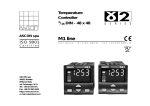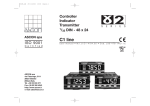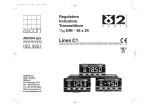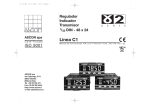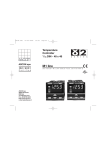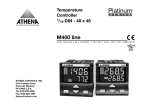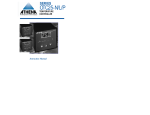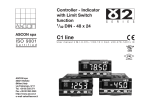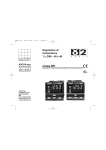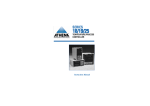Download Athena C10 line User manual
Transcript
Controller Indicator Transmitter 1/ 32 DIN - 48 x 24 C10 line c User manual • M.I.U.C10-1/02.06 • Cod. J30-478-1AC1 SEA C UL LISTED ATHENA CONTROLS, INC. 5145 Campus Drive Plymouth Meeting PA 19462 U.S.A. Tel: (610) 828-2490 Fax: (610) 828-7084 AthenaControls.com US Controller Indicator Transmitter 1/ 32 DIN - 48 x 24 c C10 line C UL LISTED 274.8 US information c NOTES ON ELECTRIC SAFETY AND ELECTROMAGNETIC COMPATIBILITY. Please, read carefully these instructions before proceeding with the installation of the controller. Class II instrument, rear panel mounting. This controller has been designed with compliance to: Regulations on electrical apparatus (appliance, systems and installations) according to the European Community directive 73/23 CEE amended by the European Comunity directive 93/68 CEE and the Regulations on the essential protection requirements in electrical apparatus EN 610101 (IEC 1010 - 1) : 90 +A1:92 + A2:95. Regulations on Electromagnetic Compatibility according to the European Community directive n089/336/CEE, amended by the European Community directive n° 92/31/CEE and the following regulations: Regulations on RF emissions EN50081 - 1 residential environments EN50081 - 2 for industrial environments Regulation on RF immunity EN500082-2 for industrial equipment and system It is important to understand that it’s responsibility of the installer to ensure the compliance of the regulations on safety requirements and EMC. The device has no user serviceable parts and requires special equipment and specialised engineers. Therefore, a repair can be hardly carried on directly by the user. For this purpose, the manufacturer provides technical assistance and the repair service for its Customers. Please, contact your nearest Agent for further information. 2 All the information and warnings about safety and electromagnetic compatibility are marked with the B sign, at the side of the note. Table of contents TABLE OF CONTENTS 1 2 3 4 5 6 INSTALLATION ...........................................................................................................................Page ELECTRICAL CONNECTIONS.....................................................................................Page PRODUCT CODING ..............................................................................................................Page OPERATIONS..............................................................................................................................Page AUTOMATIC TUNE...............................................................................................................Page TECHNICAL SPECIFICATIONS ...................................................................................Page Resources 4 8 14 18 28 29 Operating mode Control Alarms Main universal input Retransmission PV OP1 PV Indication 0 only OP1 OP2 OP4 Single 1 output OP1 OP2 OP4 Single 2 output OP2 OP1 OP4 OP2 C10 OP4 (option) Setpoint Fuzzy tuning with automatic selection Modbus RS485 Parameterisation Supervision One shot Auto tuning One shot Natural frequency 3 1 - Installation 1 INSTALLATION Installation must only be carried out by qualified personnel. 1.1 GENERAL DESCRIPTION IP 20 Termination Unit EN61010 - 1 (IEC1010 - 1) Product code label Before proceeding with the installation of this controller, follow the instructions illustrated in this manual and, particularly the installation precautions marked with the B symbol, related to the European Community directive on electrical protection and electromagnetic compatibility. Panel surface B To prevent hands or metal touching parts that may be electrically live, the controllers must be installed in an enclosure and/or in a cubicle. Mounting clamps Sealin front panel gasket Front panel IP65 protection EN 60529 (IEC 529) 4 1 - Installation 1.2 DIMENSIONAL DETAILS 1.3 PANEL CUT-OUT 48 mm 1.89 in 65 mm min 2.56 in min 22.2+0.3 mm 0.87+0.01 in 20 mm max 0.79 in max 42 mm min. 1.65 in min. 25 mm 0.99 in 45+0.6 mm 1.78+0.023 in 120 mm 4.72 in 5 1 - Installation B 1.4 ENVIRONMENTAL RATINGS Operating conditions M T %Rh Altitude up to 2000 m Temperature 0…50°C Relative humidity 5…95 % non-condensing Suggestions Special conditions M T %Rh P Altitude > 2000 m Temperature >50°C 6 Use forced air ventilation Humidity > 95 % Warm up Conducting atmosphere Use filter Forbidden Conditions C E Use 24V~ supply version D Corrosive atmosphere Explosive atmosphere 1 - Installation 1.5 PANEL MOUNTING 1.5.1 INSERT THE INSTRUMENT 1.5.2 INSTALLATION SECURING 1.5.3 CLAMPS REMOVING 1 Prepare panel cut-out 2 Check front panel gasket position 3 Insert the instrument through the cut-out 1 Position the mounting clamps 2 Push the mounting clamps towards the panel surface to secure the instrument 1 Insert the screwdriver in the clips of the clamps 2 Rotate the screwdriver 1 1 2 3 2 2 1 1 B 1.5.4 INSTRUMENT UNPLUGGING 1 Push and 2 pull to remove the instrument Electrostatic discharges can damage the instrument Before removing the instrument the operator must discharge himself to ground 1MΩ 1 2 1 7 2 - Electrical connections 2 ELECTRICAL CONNECTIONS 7 8 9 +18V— OUT OP2 - L 10 11 12 5.7 mm 0.22 in 10 11 12 1 2 3 4 5 6 NO C OP1 N RTD 9 1 2 3 4 5 6 b 8 B 7 L Rear terminal cover 0,5 Nm A RS485 (OP4) B 2.1 TERMINATION UNIT Cable size 0,5…1,5 mm2 (22 a 16 AWG) TC mA 12 screw terminals mV F50- 474 1A1C1 Option terminals Holding screw 0.5 Nm Positive screw driver PH1 Negative screw driver 0,8 x 4 mm Recommended wire terminal leads Pin connector q 1.4 mm - 0.055 in max Fork-shape AMP 165004 Ø 5.5 mm - 0.21 in Ø L 8 Stripped wire L 5.5 mm - 0.21 in 2 - Electrical connections PRECAUTIONS B Despite the fact that the instrument has been designed to work in an harsh and noisy environmental (level IV of the industrial standard IEC 801-4), it is strongly recommended to follow the following suggestions. A All the wiring must comply with the local regulations. 2.2 RECOMMENDED ROUTING OF WIRES B Conduit for low level sensor cables D 7 E 8 L 1 9 10 C 11 N 12 7 IN 2 3 4 5 D 8 L 6 E 1 9 10 11 N 2 C 12 IN 3 4 5 6 The supply wiring should be routed away from the power cables. Avoid to use electromagnetic contactors, power relays and high power motors nearby. Avoid power units nearby, especially if controlled in phase angle Keep the low level sensor input wires away from the power lines and the output cables. If this is not achievable, use shielded cables on the sensor input, with the shield connected to earth. A B A B A = Supply B = Outputs C = Analog inputs D = Analogue output Serial communications E = SSR drive output Conduit for supply and output cables 9 2 - Electrical connections B 2.3 TYPICAL INSTRUMENT WIRING V~ Load Solid state relays 4…20mA 0P4 Retransmission RS485 RX/TX 7 8 9 10 18V 12 OP2 Power supply switch Fuse 0.2 A T [4] Supervisory OP1 1 V~ 2 3 A 4 5 6 Pt100 B B L Supply V~ N [6] Fuse [5] V~ Coil of the load contactor 10 11 Thermocouple DC voltage Current 2.5 Ω external shunt resistor PV 2 wire transmitter Notes: 1] Make sure that the power supply voltage is the same indicated on the instrument. 2] Switch on the power supply only after that all the electrical connections have been completed. 3] In accordance with the safety regulations, the power supply switch shall bring the identification of the relevant instrument. The power supply switch shall be easily accessible from the operator. 4] The instrument is protected with a 0.2 A~ T fuse. In case of failure it is suggested to return the instrument to the manufacturer for repair. 5] To protect the instrument internal circuits use: - 2 A~ T fuses for Relay outputs - 1 A~ T fuses for Triac outputs 6] Relay contacts are already protected with varistors. Only in case of 24 V ~ inductive loads, use model A51-06530D7 varistors (on request) 2 - Electrical connections Switching power supply with multiple isolation and internal fuse • Standard version: nominal voltage: 100 - 240V~ (- 15% + 10%) Frequency 50/60Hz • Low Voltage version: Nominal voltage: 24V~ (- 25% + 12%) Frequency 50/60Hz or 24V– (- 15% + 25%) • Power consumption 1.6W max A] Single relay output • NO contact for resistive load of up to 2A / 250V~ max. • Fuse 2A~ T (IEC 127) B] Triac Output • NO contact for resistive load of up to 1A / 250V~ max. • Fuse 1A~ T (IEC 127) 0.2A included fuse 1 B 2.3.2 OP1 OUTPUT 3 4 Varistor for inductive loads 24V~ only Fuse B Coil of the load contactor 3 Fuse 2.3.1 POWER SUPPLY 4 Varistor for inductive loads 24V~ only Coil of the load contactor 2 B 2.3.3 OP2 OUTPUT L N Supply • Logic output, not isolated 0...5V–, ±20%, 30mA max Load Solid state relay 10 11 11 2 - Electrical connections B 2.3.4 PV CONTROL INPUT For L J K S T thermocouple type 5 5 6 wire resistance 150Ω max For PT100 resistance thermometer • If a 3 wires system is used, use always cables of the same diameter (1mm2 min.) (line 20 Ω/lead maximum resistance) • When using a 2 wires system, use always cables of the same diameter (1,5mm2 min.) and put a jumper between terminals 5 and 6 A When the distance between the controller and the sensor is 15 mt. using a cable of 1.5 mm2 diameter, produces an error on the measure of 1°C. 5 B 6 B 12 For 3 wires only A 20 Ω/lead maximum resistance For ∆T (2 x RTD Pt100) Special 5 A 6 B R1 R2 12 Use wires of the same length and A 1.5 mm2 size. 20 Ω/lead maximum resistance. 6 mA External shunt 2.5Ω mV Rj >10MΩ With 2 wire transducer 18Vdc 9 PV R1 + R2 must be < 320Ω 12 For mA, mV and V 5 6 external shunt 2.5Ω 4…20mA • Connect the wires with the polarity as shown • Use always compensation cable of the correct type for the thermocouple used • The shield, if present, must be connected to a proper earth. Transducer With 3 wire transducer 18Vdc 9 5 6 external shunt 2.5Ω Transducer PV 2 - Electrical connections B 2.3.5 OP4 OUTPUT (option) PV retransmission • Galvanic isolation 500V~/1 min. • 0/4...20mA, 750Ω/ 15V– max Load 7 8 mA B 2.3.6 SERIAL COMMUNICATIONS (option) A Please, read the user RX TX • Galvanic isolation 500V~/1 min • Compliance to the EIA RS485 standard for Modbus/Jbus 7 instructions on the “C10 controller MODBUS/JBUS protocol” 8 13 3 - Product coding 3 PRODUCT CODING The complete code is shown on the instrument label. The informations about product coding are accessible from the front panel by mean of a particular procedure described at section 4.2.2 page 19 Instrument label 3000 P/N ; C10-3000-0300 S/N : A0A-9809/0013 V~(L-N) : 100 ÷ 240V 50/60 Hz - 1.6W C UL LISTED US IND. CON. EQ. 23 FA Made in Italy Basic product code (hardware) 14 B C D L M N Configuration code (software) 3 - Product coding Line 3.1 MODEL CODE Model: C 10 The product code indicate the specific hardware configuration of the instrument, that can be modified by specialized engineers only. Basic A B C D - E F G H Line C 10 Power supply 100 - 240V~ (-15% + 10%) 24V~ (-25% + 12%) or 24V– (-15% + 25%) A 3 5 Output 1 [1] Relay Triac B 0 3 Option 1 Not provided RS485 Modbus/Jbus protocol Notes [1] Relay SPST N.O. 2A/250V; Triac 1A/250V; Logic 5V 30mA [2] Standard shunt resistor without field calibration will provide 1.10% input accuracy for 0/4-20mA input High accuracy shunt resistor without field calibration will provide 0.20% input accuracy for 0/4-20mA input Either shunt resistor with field calibration will provide 0.10% input accuracy for 0/4-20mA input Accessories Option 3 Not provided Front Bezel Color [2] Dark Grey (standard) Beige Dark Grey Beige Output 2 [1] Logic Logic Option 2 Not provided Transmitter Power Supply (PS) Transmitter PS + Retransmission Not provided Transmitter Power Supply User manual Standard English/Spanish manual 0/4-20mA Input Shunt Resistor [2] Standard resistor Standard resistor High accuracy resistor High accuracy resistor Mounting (DIN rail mounting does not include UL) Panel (standard) DIN rail with display DIN rail without display (requires CD option code 50 or 56) C 0 0 0 5 5 D 0 6 7 0 6 E F 0 3 G 0 1 2 3 H 0 1 2 15 3 - Product coding 3.2 CONFIGURATION CODING The configuration code consists of 4 digits that identify the operating characteristic of the controller, as chosen by the user. Section 4.5 at pag. 26 reports the instructions how to set a new configuration code. I L M N Input type and range TR Pt100 IEC751 TR Pt100 IEC751 TC L Fe-Const DIN43710 TC J Fe-Cu45% Ni IEC584 TC T Cu-CuNi TC K Cromel -Alumel IEC584 TC S Pt10%Rh-Pt IEC584 DC input 0…50 mV, linear DC input 10…50 mV, linear Custom input and range Control mode 2002 P.I.D. On - Off The configuration code can be displayed on the front panel, following the instructions at pag 19 section 4.2.2. 2 alarms indicator I -99.9…572.9 °F 0 -99.9…300.0 °C -328…1112 °F 1 -200…600 °C 32…1112 °F 0…600 °C 2 32…1112 °F 0…600 °C 3 -328…752 °F -200 …400 °C 4 32…2192 °F 0…1200 °C 5 32…2912 °F 0…1600 °C 6 engineering units [1] 7 engineering units [1] 8 9 Output configuration Control OP1 / alarm AL2 on OP2 Control OP2 / alarm AL2 on OP1 Control OP1 / alarm AL2 on OP2 Control OP2 / alarm AL2 on OP1 Alarm AL1 on OP1/ alarm AL2 on OP2 Alarm AL1 on OP2/ alarm AL2 on OP1 Type of control and safety Reverse (AL1 active low) Direct (AL1 active high) Reverse (AL1 active low) Direct (AL1 active high) Safety 0% Safety 0% Safety 100% Safety 100% Note [1] 0...20 & 4...20mA with provided external 2.5 Ω resistor. 16 L 0 1 2 3 4 5 M 0 1 2 3 3 - Product coding A If, when the controller is powered up for the first time, the display shows the following message it means that the controller has not been configured yet. The controller remains in stand-by until the configuration code is set correctly (see chapter 4.6 pag 26). Alarm 2 type and function Not active Sensor break alarm active high Absolute active low active high Deviation [1] active low active out (of the band) Deviation band [1] active in (the band) N 0 1 2 3 4 5 6 7 Note [1] Choice not available when the controller has been configured as 2 alarms indicator ( L digit assigned to 4 or 5) 17 4 - Operations 4 OPERATIONS 4.1 KEYPAD COMMANDS AND DISPLAY OP1 output ON (red) OP2 output ON (red) Tuning in progress (green) Menu access Enter key for selection and value setting confirmation Values modification • PV control input (operator mode) (in engineering units) when the measured value is greater than sensor high range when the measured value is less than the sensor low range • Code and/or value of the Parameter (programming mode) 18 4 - Operations 4.2 DISPLAY When the display operation is selected, the controller presents automatically all the most important parameters and configuration information. During the operation, the parameters values cannot be modified by the user After 2 sec from the end of the operation, the controller flashes the display and returns to the normal operating conditions. 4.2.1 OF THE PROCESS VARIABLES Operator mode 4.2.2 OF THE CONFIGURATION CODES 274.8 Operator mode after 0,5 sec. Engineering units [1] after 0,5 sec. Engineering units [1] Unit Unit °C °C Setpoint s.p. Control output [2] Basic product code (see page 15) Hard 3000 270.5 Note [1] See table page 27 [2] This display is not presented if the instrument has been configured as an On - Off controller 274.8 Configuration code (see page 16) Conf Out 2002 63.0 Software release number rel. 00A Example: C10 - 3000 - 2002 / Release 00A 19 4 - Operations 4.3 PARAMETER SETTING 4.3.1 NUMERIC ENTRY (i.e. the modification of the value of a stored Setpoint from 275.0 to 240.0) Press S or G momentarily to change the value of 1 unit every push Continued pressing of S or G changes the value, at rate that doubles every second. Releasing the button the rate of change decreases. In any case the change of the value stops when it has reached the max/min limit set for the parameter. 274.8 Operator mode 275.0 Current setpoint display —lower 230.0 Setpoint modification —raise 240.0 after 2 sec. 240.0 20 Setpoint entry. The operation is acknowledged by one flash of the display. 4 - Operations 4.3.2 MNEMONIC CODES SETTING (e.g. configuration see pages 26, 27) Press the S or G to display the next or previous mnemonic for the selected parameter. Continued pressing of S or G will display further mnemonics at a rate of one mnemonic every 0.5 sec. The mnemonic displayed at the time the next parameter is selected, is the one stored in the parameter. Unit Engineering Units °C Degree Centigrade °f Degree Fahrenheit none no units defined °f Degree Fahrenheit ph Ph 21 4 - Operations 4.4 PARAMETER SETTING P 274.8 PASS Values modification Parameter Modification/ menù selection selection entry A The parameter setting procedure has a timeout. If no keys are pressed for, at least, 30 seconds, the controller switches back, automatically, to the operator mode. After having selected the parameter or the code, press S and G to display or modify the value (see pag. 20) The value is entered when the next parameter is selected, by pressing the R key. Pressing the Q key, the next group of parameters is presented on the display. 22 0 Operator mode Password entry [3] only if Code value ≥5000 (see pages 26…27) AIs.p P 0 A2s.p P 5000 Back to the Operator mode NO OK 1st GROUP AL1 alarm threshold [1] (see pag. 24) AL2 alarm threshold [2] (see pag. 24) 5:0 p.b. Code entry [3] from 5000 to 9999 Must be equal to the value of the parameter Code P Proportional band (PID algorithm only) 0.5…999.9% of span 5:0 t.i. YES Integral time (PID algorithm only) 0ff / 0.0 ...100.0 min. P 1:00 Note [1] It is presented only if the controller has been configured with 2 alarms. Digit L of the configuration code is assigned to 4 or 5 [2] It is not presented if the controller has been configured with alarm n° 2 not active or of sensor break type. Digit N of the configuration code is assigned to 0 or 1. [3] If password is 0000 to 4999, parameter setting will be available to the operator without entering this password number. If password is 5000 to 9999, parameter setting will only be available by entering this password number. P t.d. Derivative time (PID algorithm only) 0ff / 0.01 ... 10.00 min. 20 t.c. Cycle time (PID algorithm only) 1 ... 200 sec. 4 - Operations PARAMETER MENÙ tune 2nd GROUP Tune run/stop (PID algorithm only) pass P Off sl. u Setpoint ramp up (not available with 2 alarms) 0ff/0.1…999.9 digit/min P Off Setpoint ramp down (not available with 2 alarms) 0ff/0.1…999.9 digit/min P Setpoint low limit (not available with 2 alarms) low range …s.p. H P Setpoint high limit (not available with 2 alarms) s.p. l…high range PILn.sP ala . rPacnge AL1 hysteresis 0.1…10.0% of the span [1] PF H.sP .c rPaala nge t.fil Password entry [3] only if Code value <5000 (see pages 26…27) Direct access to the configuration (pages 26 … 27) Filter time constant 0ff/ 1...30 sec. P Off P 1:00 O.C. sl. d Overshoot control (PID algorithm only) 0.01…1.00 P Op. H s.p. l s.p. H Control output hysteresis (On-Off control only) 0.1… 10.0% of span P Addr rt.lo 0:5 AIhy P Back to the 1st parameter group 1 PF H.sP .c rPaala nge 0:5 hy. In.sh Input shift 0ff/ -60...60 digits PILn.sP ala . rPacnge P100:0 Control output high limit (PID algorithm only) 10.0…100.0% 0 rt.Hi 0:5 A2hy AL2 hysteresis 0.1…10.0% of the span [2] Communication address (if option installed) 0ff / 1…247 Retransmission low range (if option installed) full scale Retransmission high range (if option installed) full scale Back to the 1st parameter of the 2nd group 23 4 - Operations 4.5 PARAMETER Sensor break or input disconnection Sensor 1st GROUP The controller parameters have been organized in group, according to their functionality area. AL1 alarm threshold The threshold is presented only if the controller have been configured with 2 alarms. ( Digit L of the configuration code assigned to 4 or 5) A # Is.p AL2 alarm threshold The alarm occurrences handle the OP1 and OP2 outputs, in different ways, according to the configured types of alarms, as illustrated. A # 2s.p Visualisation over-range T under-range Absolute alarm (full scale) On Active Off high On Off Active low hy low range Alarm threshold high range Deviation alarm On Active Off high SP On Off Active low hy Proportional band This parameter specifies the proportional band coefficient that multiplies the error (SP - PV) p # b . . Integral time It is the integral time value, that - low range Alarm threshold 24 On Active Off out On Off full scale Control output cycle time It’s the cycle time of the time proportioning control output. The PID control output is provided through the pulse width modulation of the digital waveform. t # c . . Overshoot control This parameter specifies the span of action of the overshoot control. Setting lower values (0.99 —> 0.01) the overshoot generated by a Setpoint change is reduced. The overshoot control doesn’t affect the O # C . . SP hy Derivative time It is the derivative term coefficient that specifies the time required by the proportional term P to reach the level of D. When Off the derivative term is not included in the control algorithm. t # d . . + high range Band alarm t # i . . specifies the time required by the integral term to generate an output equivalent to the proportional term. When Off the integral term is not included in the control algorithm. hy alarm threshold Active in full scale 4 - Operations effectiveness of the PID algorithm. Setting 1, the overshoot control is disabled. Control output high limit It specifies the maximum value the control output can be set O # p. H Control output hysteresis h # y. Setpoint low limit Low limit of the setpoint value. When the parameter is Off, this function is disabled. s # p . . l On s # p . . H A # Ihy Off hy Control output hysteresis span, set in % of the full scale. 2nd GROUP Setpoint ramp up Setpoint ramp down This parameter specifies the maximum rate of change of the Setpoint in digit/min. When the parameter is Off, this function is disabled. s # l. u s # l. d 100% 63,2% PV 0 t.Fil Setpoint high limit High limit of the setpoint value. When the parameter is Off, this function is disabled. Hysteresis of the threshold SP Filter response AL1 alarm hysteresis AL2 alarm hysteresis Hysteresis of the threshold of both the alarms, that activate OP1 and OP2 control output. It is specified as a % of the full scale. A # 2hy Input filter time constant Time constant, in seconds, of the RC input filter applied to the PV input. When this parameter is set to Off the filter is bypassed. t # f . il I # n.sh Time Input shift This value is added to the measured PV input value. Its effect is to shift the whole PV scale of up to ± 60 digits. Controller address the address range is from 1 to 247 and must be unique for each controller on the communication bus to the supervisor. When set to Off the controller is not communicating A # ddr Retransmission low range Retransmission high range These parameters define the range of the OP4 retransmission output. Example: 4..20 mA output corresponding to 20…120°C. r # t.lo r # t.Hi 25 4 - Operations CONFIGURATION MENU 4.6 CONFIGURATION Operator mode The configuration of the controller is specified through a 4 digit code that defines the type of input, of control output and of the alarms. (sect. 3.2 pag16) Other parameters specifie the type of auxiliary functions. 274.8 1st GROUP PASS Password entry [3] only if Code value ≥5000 5000 Code entry [3] from 5000 to 9999 Must be equal to the value of the parameter Code NO Values modification Parameter Modification/ menù selection selection entry Press S or G to display the next parameter or the next code and change its value. The new value entered is stored into the controller when the next parameter is selected by pressing R. 26 Baude rate (only if comm. is installed) baud 1200/2400 OK AIs.p YES sc.lo Low range [2] (linear scale only) -999…9999 sc.Hi High range [2] (linear scale only) -999…9999 prot Communication protocol (only if communication is installed) M.bu5 / jbus 4800/9600 retr Retransmission range (only if present) 0=20 / 4=20 mA Code Password [3] 0…9999 (33 default from factory) 4 - Operations 2nd GROUP tune pAss 33 Entry of digits I-L-M-N of the configuration code (chapter 3.2 page 16) YES Code entry [3] from 0 to 4999 (33 default from factory) The entered password must correspond to the one store in the Code parameter. NO [1] Table of the supported Engineering Units. Centigrade degrees * Fahrenheit degrees * none mV Volt mA I L M N 2002 OK Password entry [3] only if Code value <5000 Note Pressing the Q the next group of parameters is displayed. A Conf Engineering units (see table) Unit N° of decimals (linear scale only) 0…3 sc.d.d If the controller has not been configured Conf is shown on the front panel at the power up. In this situation, the controller has its outputs and inputs not active. This situation ends when a correct configuration code is entered. Ampere Bar PSI Rh pH °C °f none nU U MA A bAr psI rh ph * For inputs from thermocouple or resistance thermometer, the choice is between °C and °F only. [2] Range of min 100 digits. [3] If password is 0000 to 4999, parameter setting will be available to the operator without entering this password number. If password is 5000 to 9999, parameter setting will only be available by entering this password number. 27 5 - Automatic tune 5 AUTOMATIC TUNE Start/stop of the Fuzzy Tuning The Tuning operation can be started or stopped any time. 274.8 Operator mode press until tune stop To start select strt strt To stop select stop 28 The green led 3 goes on when the Fuzzy Tuning is in progress. At the end of this operation, the calculated PID terms parameter are stored and used by the control algorithm and the controller goes back to the operator mode. The green led 3 becomes off. This function allows the calculation of the optimal PID terms parameters, monitoring the response of the process to disturbances. The controller provides 2 types of “one shot” tuning algorithm, that are selected automatically according to the process condition when the operation is started. Step response This type is selected when, at the start of the autotune operation, the PV is far from the Setpoint of more than 5% of the span. This method has the big advantage of fast calculation, with a reasonable accuracy in the term calculation. Natural frequency This type is selected when the PV is close to the SP setpoint. This method has the advantage of a better accuracy in the term calculation with a reasonable speed calculation. The Fuzzy Tuning determines automatically the best method to use to calculate the PID term, according the process conditions. Step response SP Setpoint change End of the tuning operating and setting of the new calculated terms. PV variable Start of autotune operation Control output Natural frequency tuning start PV variable End of the tuning operating and setting of the new calculated terms. Control output 6 - Technical specification 6 TECHNICAL SPECIFICATIONS Features (at 25°C enviromental temp.) Description Total configurability see par. 3.2 pag. 16 par. 4.6 pag. 26 From keypad or serial communication the user selects: the type of input - the associated functions and the corresponding outputs - the type of control algorithm - the type of output and the safe conditions - the type and functionality of the alarms - the values of all the control parameters. Common characteristics PV Input (see pag.12 and pag. 16) A/D converter with resolution of 50.000 points Update measurement time: 0.2 seconds Sampling time: 0.5 seconds Input bias: - 60…+ 60 digit Input filter with enable/disable: 1…30 seconds 0.25% ± 1 digits for temperature sensors 0.1% ±1 digits (for mV) Accuracy 0.1% ±1 digits + accuracy of the used external shunt resistor (for mA) Pt100Ω at 0°C Resistance (IEC 751) 2 or 3 wires thermometer connection °C/°Fselectable L,J,T,K,S Internal cold junction (IEC 584) Thermocouple compensation in °C/°F °C/°F selectable 4…20mA,0-20mA Engineering units DC input (current) with external shunt 2.5Ω Conf. decimal point position Init. Sc. -999…9999 Rj >10MΩ 10…50mV, 0-50mV Full Sc. -999…9999 DC input (voltage) (min. range of 100 digits) Rj >10MΩ Between 100…240V~ the error is minimal Max. wire Res.: 20Ω max (3 wires) Input drift: 0.3°C/10°C Env.Temp. <0.1°C / 10Ω Wire Res. Max.wire Res.: 150Ω max Input drift: <2µV/°C Env. Temp. <0.5µV / 10Ω Wire Res. Input drift: <0.1% / 20°C Env. temp. 29 6 - Technical specification Features (at 25°C enviromental temp.) Description Indicator with 2 alarms Operating mode and Outputs Control Mode OP1 output OP2 output AL1 alarm (indicator with 2 alarms) 1 PID loop or 1 ON-OFF loop with 1 Alarm Algorithm Proportional band (P) Integral time (I) Derivative time (D) Cycle time Overshoot control High limit Hysteresis AL1 alarm AL2 alarm OP1 - Relay or Triac OP2 - Logic OP2 - Logic OP1 - Relay or Triac Control output AL2 alarm OP1 - Relay or Triac OP2 - Logic OP2 - Logic OP1 - Relay or Triac PID with overshoot control or ON OFF 0.5…999.9% 0.1…100.0 min Off = 0 0.01…10.00 min PID algorithm 1…200 sec 0.01…1.00 100.0…10.0% ON-OFF algorithm 0.1…10.0% SPST Relay N.O., 2A/250V~ for resistive load Triac, 1A/250V~ for resistive load Logic, not isolated: 5V–, ± 10%, 30mA max Hysteresis 0.1…10,0% full scale Active high Absolute threshold, whole range Active low Hysteresis 0.1…10,0% c.s. Active high AL2 alarm Action type Action Active low Special function 30 Sensor break Deviation threshold ±range Band threshold 0…range Absolute threshold whole range 6 - Technical specification Features (at 25°C enviromental temp.) Description Setpoint Ramp up and down Low limit High limit OP4 PV retransmission (option) One shot Fuzzy-Tuning with automatic selection Serial comm. (option) Auxiliary Supply Galvanic isolation: 500 V~/1 min Current output: 0/4…20mA 750Ω/15V max Resolution 12bit (0.025%) Accuracy: 0.1 % The controller selects automatically the best Step response method according to the process conditions Natural frequency RS485 isolated, Modbus/Jbus protocol, 1200, 2400, 4800, 9600 bit/sec 2 wires +18V– ±20%, 30mA max for an external transmitter supply Measure input Operational safety Control output Parameters Access protection Power supply General characteristics 0.1…999.9 digit/min (Off = 0) From low range to the high limit From low limit to the high range Electric safety Electromagnetic compatibility Approvals Protection EN650529 Dimensions Detection of out of range, short circuit or sensor break with automatic activation of the safety strategies and alerts on display Safety value: 0…+100%. (user enabled/disabled) parameter and configuration data are stored in a non volatile memory for an unlimited time Password to access the configuration and parameters data 100 - 240V~ (- 15% + 10%) 50/60Hz or 24V~ (- 25% + 12%) 50/60Hz and 24V– (- 15% + 25%) Power consumption 1.6W max Compliance to EN61010, installation class 2 (2500V) pollution class 2 Compliance to the CE standards for industrial system and equipment UL, cUL IP20 termination unit IP65 front panel 1/ DIN - 48 x 24, depth 120 mm, weight 100 gr. apx. 32 31 1 WARRANTY We warrant that the products will be free from defects in material and workmanship for 3 years from the date of delivery. The warranty above shall not apply for any failure caused by the use of the product not in line with the instructions reported on this manual. 32 CSG srl • New Media Communications • www.csg-net.it warranty ICONS TABLE Main universal input Digital input Digital input connected functions Thermocouple Isolated contact Auto/Manual RTD (Pt100) NPN open collector Run, Hold, Reset and program selection Delta Temp (2x RTD) TTL open collector PV hold mA and mV Setpoint Custom Setpoint slopes inhibition Local Output Stand-by SPST Relay Keypad lock Triac Current transformer Outputs lock SPDT Relay mA Remote setpoint Start-up function mA Volt Remote setpoint Timer function mA mV Feedback potentiometer Memorized Logic Frequency Auxiliary input Remote Setpoint programmer 33


































